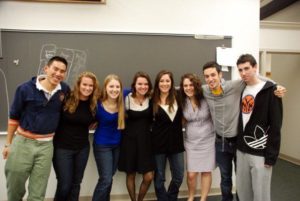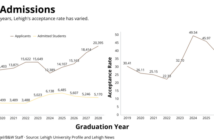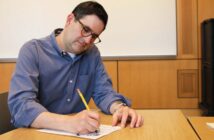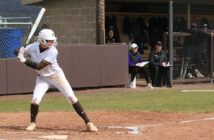
Members of the spring 2010 editorial board pose together in Coppee Hall. Andrew Daniels, ‘10, (second from right) was the editor in chief at the time. (Courtesy of Andrew Daniels)
Coppee Hall sits between the iconic stone buildings of Drown Hall and Linderman Library. For many students, it sits at a crossroads, as a path to more populated academic buildings that converge in front of Coppee’s front door, protected on either side by stone figures mounted to the walls.
For editors of The Brown and White, Coppee is where afternoons turn into late nights to bring the paper to life. Years and years passed before the semi-weekly paper transitioned from being solely a print publication to a significant online presence as well.
The members of the spring 2010 editorial board began working for The Brown and White in 2006. By the time that the they were preparing for graduation, online content began to be their focus.
Andrew Daniels, ’10, started as a news writer before working his way up to managing editor and editor in chief in fall 2009 and spring 2010, respectively. Taking an easier course load to devote more time to the paper, Daniels said the editorial board members took it upon themselves to represent the university and make it a larger portion of their lives.
The editors had complete autonomy, laying the foundation for both a fun and frightening experience while accepting the challenges of being a student-run newspaper.
Elaine (Hardenstine) Kenig, ’10, was the managing online editor in fall 2009 and managing editor in spring 2010.
“We went to school during the middle of the financial crisis, and the publication industry was starting to shift,” Kenig said. “We felt the change toward online.”
During Kenig’s and Daniels’ first year at the paper, they paid little attention to publishing online. The website used to be only an afterthought — only publishing breaking news pieces immediately online when it was a big story.
By their senior year, however, the editorial board was starting to think about the possibilities and how to expand the publication’s online presence.
“We were throwing stuff against a wall to see what stuck,” Daniels said. “The internet was our sandbox. We decided to try things and see what worked.”
He described the pioneering as liberating. There was no model. They could write the playbook themselves.
There used to be editor positions dedicated to online, such as managing online editor and section online editors. For Adrienne Smith, ’10, the role of managing online editor changed her life.
“I became interested in a career with content marketing,” Smith said. “I was introduced to a lot of smart people.”
In spring 2010, the editorial board was trying to figure out what to do beyond sharing links to online articles. Posting articles only online felt like a big step to the group, but the board recognized that content didn’t have to be in the print publication to still be considered published.
A transition was in the works, and the editors welcomed the challenge with open arms.
During some nights, the editorial board would hold its meetings on the Coppee rooftop, perched over campus, as they exchanged conversations with different perspectives, pulling stories together. Daniels said he believes the long nights in Coppee were where strong friendships were made.
The sense of community meant everything to Kenig, she said. Journalism majors were working alongside people in other majors, but everyone was reaching for the same goal — to develop quality content so their fellow classmates would know what was happening on and around campus.
“Student newspapers are ways for the student body to stay connected,” Kenig said. “Someone needs to be talking about what’s going on.”
Daniels became Men’s Health magazine’s first online reporter, traveling around the country to write. He attributes the experience he had at the paper to playing an invaluable role toward securing opportunities in his professional career.
Smith worked at CBS as a digital lifestyle editor, a role she said was made possible through her experience working with online content at The Brown and White. Like the paper, CBS was also figuring out its online identity during her time there, she said.
Kenig applied the skills of editing, writing concisely and working on headlines on the student publication to her career.
Kenig, Smith and Daniels all stay up to date with The Brown and White through social media and notice a continuing increased presence online. The concept of breaking news through Twitter was not used frequently, and the incorporation of video only adds to the list of changes the paper has gone through as the journalism industry itself has changed over the years.
“It’s fun to see coverage happen almost exclusively from social media,” Smith said. “To follow along only on social was something that didn’t happen when I was there.”
Daniels credits the journalism department at Lehigh with engaging in new ways to tell stories, building up an infrastructure to allow students to master the skills necessary to be a journalist in a digitally-focused environment.
He said he believes the strides that the department has taken has led to an increase in the quality of reporting.
“I love keeping up with the progress because it gives me hope that regardless of where our crazy field is going, the new graduates entering the field of journalism are experienced,” Daniels said.





Comment policy
Comments posted to The Brown and White website are reviewed by a moderator before being approved. Incendiary speech or harassing language, including comments targeted at individuals, may be deemed unacceptable and not published. Spam and other soliciting will also be declined.
The Brown and White also reserves the right to not publish entirely anonymous comments.